How to Choose a Sustainable Place to Live
Moving to a new town can be an exciting time! It’s full of new opportunities for you. As you move, you might be considering the sustainability of where you’re going to live.
As you research places to build, buy or rent, look for ways to stay eco-friendly. You can always purchase green building materials and energy-efficient appliances. However, most of the time, you can be more sustainable by reviewing where you decide to settle down.
Locations have different efficiencies that all include factors such as climate, weather and the surrounding ecosystems, as well as proximity to amenities. Here’s how to choose a sustainable place to live so you can continue living an eco-friendly life once you move to your new location.
Live Where Someone Else Lived
Whether you’re planning to rent, buy or build, choose a site where someone else has previously lived. When a property has a house or other buildings already there, all you have to do is renovate or hook up to electricity and water.
Renovation is much more efficient than entirely starting from scratch. It takes out the work of demolishing, which can be highly wasteful of materials if you’re not careful. If a building on the property is too dangerous to use, then yes, it’s okay to demolish it. After demolition, try to salvage pieces that you can reuse, donate or recycle, then build on the existing foundation if possible.
Stay Close to Amenities
When considering a place to live, if you want to stay sustainable, then choose a location within walking or biking distance of your workplace, stores and other amenities. You’ll be able to reduce the number of times you have to drive places, which reduces the number of carbon emissions released into the air.
Besides, you’ll save money, gas and driving time. You’ll be able to live stress-free since you won’t have to worry about getting stuck in traffic. Plus, if you ever resell your home, the value will be higher since you’re near stores, schools and other amenities.
Hook Up to Existing Infrastructure
If you plan to build, look for locations where you can easily hook up to existing infrastructure. This is usually in developing or developed neighborhoods where you can access roads, utility lines, water and wastewater.
This saves the energy needed to bring all of those utilities to you. If you plan to live a homestead life, then you don’t need to worry about this as much.
Avoid Sensitive Habitats
It doesn’t matter if you’re building or buying — steer clear of sensitive habitats at all costs. These are habitats that are home to endangered species, agricultural land and wetlands. There are certainly plenty of other places you can choose to live.
By leaving these areas alone, you’re committing to sustainability and helping protect the local environment. These regions are prone to erosion, water pollution and habitat destruction. Typically, you can tell if an area is sensitive if it’s far away from existing developments and communities.
Think About the Local Climate
Building a home can be great. You get to decide how you want everything designed, and you don’t have to go off of existing infrastructure. However, don’t just choose a location and then build a cookie-cutter home like the ones you see all across the country.
Instead, consider the local climate. That’s why homes in hotter climates are often made of materials like adobe to be more energy-efficient to keep the house cool. Research the climate and weather patterns before choosing materials to build your home so you can make it the most energy-efficient.
Eco-Friendly Places to Live
Most other countries around the world are more eco-friendly than America. For example, Zurich, Switzerland, is one of the most eco-friendly places to live. The people there are always conscious of the environment, and there are plenty of public transportation options that cut down on car usage. Also, Vancouver, Canada, boasts of being a sustainable city. Bike paths, parks and green spaces for its residents fill the town.
There are a few cities in America that are high on the sustainable list. Corvallis, Oregon, is one of the best green places to live. They’re great with recycling, using renewable energy and conserve water. Other states in America that are great for living green include Hawaii, Montana and Alaska. Choosing one of these locations will increase your level of living sustainably.
Where Will You Live?
You can live sustainably no matter where you go. By using these tips to choose a sustainable place to live, you’ll be helping the environment and living a healthier lifestyle.
Author Bio:
Jane is the editor-in-chief and founder of Environment.co. She is passionate about helping people understand the importance of sustainability and actionable steps to live a greener lifestyle.



